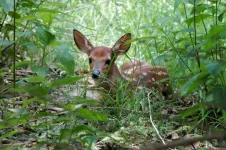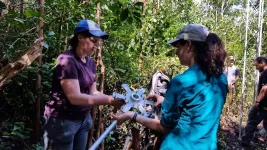(Press-News.org) CAMBRIDGE, MA -- When we experience a new event, our brain records a memory of not only what happened, but also the context, including the time and location of the event. A new study from MIT neuroscientists sheds light on how the timing of a memory is encoded in the hippocampus, and suggests that time and space are encoded separately.
In a study of mice, the researchers identified a hippocampal circuit that the animals used to store information about the timing of when they should turn left or right in a maze. When this circuit was blocked, the mice were unable to remember which way they were supposed to turn next. However, disrupting the circuit did not appear to impair their memory of where they were in space.
The findings add to a growing body of evidence suggesting that when we form new memories, different populations of neurons in the brain encode time and place information, the researchers say.
"There is an emerging view that 'place cells' and 'time cells' organize memories by mapping information onto the hippocampus. This spatial and temporal context serves as a scaffold that allows us to build our own personal timeline of memories," says Chris MacDonald, a research scientist at MIT's Picower Institute for Learning and Memory and the lead author of the study.
Susumu Tonegawa, the Picower Professor of Biology and Neuroscience at the RIKEN-MIT Laboratory of Neural Circuit Genetics at the Picower Institute, is the senior author of the study, which appears this week in the Proceedings of the National Academy of Sciences.
Time and place
About 50 years ago, neuroscientists discovered that the brain's hippocampus contains neurons that encode memories of specific locations. These cells, known as place cells, store information that becomes part of the context of a particular memory.
The other critical piece of context for any given memory is the timing. In 2011, MacDonald and the late Howard Eichenbaum, a professor of psychological and brain sciences at Boston University, discovered cells that keep track of time, in a part of the hippocampus called CA1.
In that study, MacDonald, who was then a postdoc at Boston University, found that these cells showed specific timing-related firing patterns when mice were trained to associate two stimuli -- an object and an odor -- that were presented with a 10-second delay between them. When the delay was extended to 20 seconds, the cells reorganized their firing patterns to last 20 seconds instead of 10.
"It's almost like they're forming a new representation of a temporal context, much like a spatial context," MacDonald says. "The emerging view seems to be that both place and time cells organize memory by mapping experience to a representation of context that is defined by time and space."
In the new study, the researchers wanted to investigate which other parts of the brain might be feeding CA1 timing information. Some previous studies had suggested that a nearby part of the hippocampus called CA2 might be involved in keeping track of time. CA2 is a very small region of the hippocampus that has not been extensively studied, but it has been shown to have strong connections to CA1.
To study the links between CA2 and CA1, the researchers used an engineered mouse model in which they could use light to control the activity of neurons in the CA2 region. They trained the mice to run a figure-eight maze in which they would earn a reward if they alternated turning left and right each time they ran the maze. Between each trial, they ran on a treadmill for 10 seconds, and during this time, they had to remember which direction they had turned on the previous trial, so they could do the opposite on the upcoming trial.
When the researchers turned off CA2 activity while the mice were on the treadmill, they found that the mice performed very poorly at the task, suggesting that they could no longer remember which direction they had turned in the previous trial.
"When the animals are performing normally, there is a sequence of cells in CA1 that ticks off during this temporal coding phase," MacDonald says. "When you inhibit the CA2, what you see is the temporal coding in CA1 becomes less precise and more smeared out in time. It becomes destabilized, and that seems to correlate with them also performing poorly on that task."
Memory circuits
When the researchers used light to inhibit CA2 neurons while the mice were running the maze, they found little effect on the CA1 "place cells" that allow the mice to remember where they are. The findings suggest that spatial and timing information are encoded preferentially by different parts of the hippocampus, MacDonald says.
"One thing that's exciting about this work is this idea that spatial and temporal information can operate in parallel and might merge or separate at different points in the circuit, depending on what you need to accomplish from a memory standpoint," he says.
MacDonald is now planning additional studies of time perception, including how we perceive time under different circumstances, and how our perception of time influences our behavior. Another question he hopes to pursue is whether the brain has different mechanisms for keeping track of events that are separated by seconds and events that are separated by much longer periods of time.
"Somehow the information that we store in memory preserves the sequential order of events across very different timescales, and I'm very interested in how it is that we're able to do that," he says.
INFORMATION:
The research was funded by the RIKEN Center for Brain Science, the Howard Hughes Medical Institute, and the JPB Foundation.
North Carolina State University-led researchers have developed an analytical measurement "framework" which could allow organic solar cell researchers and manufacturers to determine which materials will produce the most stable solar cells prior to manufacture.
Organic solar cells have increased in efficiency over the past decades, but researchers and manufacturers still struggle with determining which material combinations work best and why, as well as with achieving stable morphology and operation.
"There is still a lot of 'trial and error' guesswork involved in identifying promising materials for these solar cells," says Harald Ade, Goodnight Innovation Distinguished Professor of Physics at NC State and co-corresponding author of the research. ...
Two studies in today's Nature Neuroscience, led by researchers at Boston Children's Hospital, Brigham and Women's Hospital (BWH), and Harvard Medical School (HMS), implicate mosaic mutations arising during embryonic development as a cause of autism spectrum disorder (ASD). The findings open new areas for exploring the genetics of ASD and could eventually inform diagnostic testing.
Mosaic mutations affect only a portion of a person's cells. Rather than being inherited, they arise as a "mistake" introduced when a stem cell divides. A mutation in a stem cell will only be passed to the cells that descend from it, producing the mosaic pattern. ...
Reza Shahbazian-Yassar, professor of mechanical and industrial engineering at the University of Illinois Chicago.
Shahbazian-Yassar and colleagues facilitated the development of a cutting edge "Swiss Army knife" catalyst made up of 10 different elements - each of which on its own has the ability to reduce the combustion temperature of methane - plus oxygen. This unique catalyst can bring the combustion temperature of methane down by about half - from above 1400 degrees Kelvin down to 600 to 700 degrees Kelvin.
Their findings are reported in the journal Nature Catalysis.
In previously-published research, ...
Tales of post-apocalyptic landscapes in which few survivors emerge into a new and much different world have long been popular tales woven by screenwriters and authors. While many enjoy these stories, thinking of them as nothing but a guilty pleasure, they may not realize that immersing themselves in fiction has prepared them for the reality of 2020, according to a team of researchers.
John Johnson, professor emeritus of psychology at Penn State, recently conducted research with several colleagues revealing that an individual's enjoyment of horror films could have better prepared them for the COVID-19 pandemic as opposed to others who do not enjoy frightening entertainment. Their findings are documented in Personality and Individual Differences.
"My latest ...
The first-ever study of the levels of the stress hormone cortisol in the saliva of newborn white-tailed deer fawns yielded thought-provoking results that have Penn State researchers suggesting predation is not the only thing in the wild killing fawns.
"We think the hormone offers a way to evaluate factors in the environment that affect fawns, such as disease, but are difficult to evaluate when just looking at a carcass that has been picked over by predators," said researcher Duane Diefenbach, adjunct professor of wildlife ecology. "By then, it's impossible to be certain what ...
University of Wyoming researchers headed a study that shows nonnative birds in Oahu, Hawaii, have taken over the role of seed dispersal networks on the island, with most of the seeds coming from nonnative plants.
"Hawaii is one of the most altered ecosystems in the world, and we are lucky enough to examine how these nonnative-dominated communities alter important processes, such as seed dispersal," says Corey Tarwater, an assistant professor in the UW Department of Zoology and Physiology. "What we have found is that not only do nonnative species dominate species ...
Boston, Mass. - As the number of COVID-19 infections continues to rise nationwide, more than 360,000 Americans have already died from the potentially deadly viral infection. But recent reports describe an increase in mortality during the pandemic that cannot be explained by COVID-19 deaths alone.
In a new study from the Richard A. and Susan F. Smith Center for Outcomes Research in Cardiology at Beth Israel Deaconess Medical Center (BIDMC), researchers analyzed data from the National Center for Health Statistics to compare the rate of cardiovascular-related deaths before and after the onset of the pandemic in ...
Mindfulness courses can reduce anxiety, depression and stress and increase mental wellbeing within most but not all non-clinical settings, say a team of researchers at the University of Cambridge. They also found that mindfulness may be no better than other practices aimed at improving mental health and wellbeing.
Mindfulness is typically defined as 'the awareness that emerges through paying attention on purpose, in the present moment, and nonjudgmentally to the unfolding of experience moment by moment'. It has become increasingly popular in recent years as a way of increasing wellbeing and ...
Deaths from ischemic heart disease and hypertensive diseases in the United States increased during the COVID-19 pandemic over the prior year, while globally, COVID-19 was associated with significant disruptions in cardiovascular disease testing. These findings are from two papers publishing in the Journal of the American College of Cardiology that examined the indirect effects of the pandemic on cardiovascular disease patients and their care.
The impact of the COVID-19 pandemic has been substantial, but there are concerns about the indirect impact of the pandemic as well, particularly for heart disease patients. Many reports have suggested that large mortality increases during the pandemic cannot be explained by COVID-19 alone. During the height of stay-at-home orders in the U.S., hospitals ...
HOUSTON - (Jan. 11, 2021) - An atypical two-dimensional sandwich has the tasty part on the outside for scientists and engineers developing multifunctional nanodevices.
An atom-thin layer of semiconductor antimony paired with ferroelectric indium selenide would display unique properties depending on the side and polarization by an external electric field.
The field could be used to stabilize indium selenide's polarization, a long-sought property that tends to be wrecked by internal fields in materials like perovskites but would be highly useful for solar energy applications.
Calculations by Rice materials theorist Boris Yakobson, lead author and researcher Jun-Jie Zhang and graduate student Dongyang Zhu shows switching the material's polarization with an external electric field makes ...




